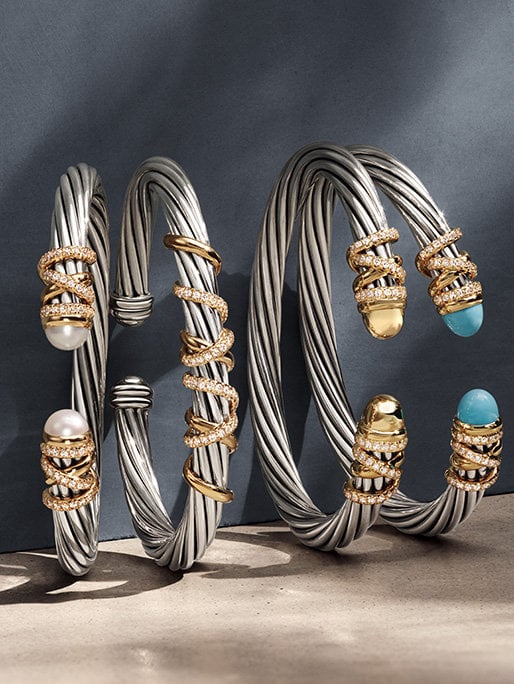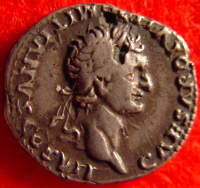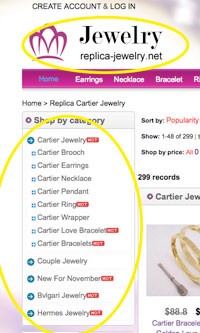Brand impersonators & counterfeit jewelry
Early this year luxury jeweler David Yurman was awarded $1.5 million in a lawsuit over knockoffs of his jewelry being sold on the internet.
Counterfeiting jewelry brands rarely makes headlines, but the practice is widespread. This case represents only the tip of an ever-growing iceberg of fake goods in the marketplace.
Counterfeiting has been around for millennia. Some folks call it the second-oldest profession. There's a counterfeit coin from the 1st century AD. It's made of copper but covered with a coating of silver. That same trick is still in use today, as buyers of supercheap jewelry online can testify.
Counterfeiting a luxury jewelry brand takes things to a new level, in terms to fraud as well as profit. It is low-quality jewelry that sells by exploiting a high-value name.
In 2017, counterfeit name-brand jewelry seized by customs authorities in the US was valued at more than $460 million. More staggering to consider: there's no way to know how much fake jewelry was not caught, how much knockoff jewelry is now being sold to unsuspecting consumers as high value merchandise.
Huge profits drive the counterfeiting of luxury goods in general, and jewelry is a star in this regard. Unlike many commonly counterfeited items, watches, rings, and other jewelry are relatively small yet quite expensive. This allows offshore counterfeiters to maximize profits in each smuggled shipment.
Unhappy shopper's tale:
"I purchased 5 pieces of jewelry from different sellers and tested them when I got them and they were all fake. . . . [They are all] stamped as being 925, 10k, or 14k. One item is even a David Yurman stamped replica ring. They turned the color of a penny after testing them with jewelry acid."
-- Consumer on a complaint website
Some low-priced jewelry is cheaply made. When a "silver ring" for two dollars turns out to be plastic coated with silver paint, the buyer is more embarrassed than angry. (Yes, there really is jewelry being sold online for two dollars, and even for pennies, and people are surprised it's junk!)
But much of the bogus name-brand jewelry are what the experts call high-end fakes, which sell for much more. They can be presented as second-hand or remaindered. Or the buyer may just think it's half price because the seller has a website rather than a store. The hopeful shopper is focused on the "bargain" of it.
Counterfeit brand labels and tags are among the most valuable items seized by customs. Stamping fakes with quality marks and brand names is easy. "Certificates of Authenticity" for various brands are available for purchase online, and even custom packaging can be duplicated.
Most bogus merchandise comes from Asia, particularly China and Hong Kong. China is a manufacturing hub with experienced and low-paid laborers, and China's cost for shipping to other countries is very low. However, the whole enterprise of copying name-brand merchandise in low-cost materials is global, with very sophisticated production and distribution channels.
For example, one Italian store owner purchased, through Georgian and Egyptian intermediaries, watches and watch parts that came from Hong Kong. Police found in the Hong Kong shipment metal plates and diagrams showing how to attach them to watch faces and how to forge a brand-name logo.
The Mushroom War gives more details on the global production of fake watches, including some specifics that distinguish counterfeits from authentic brands, and the high profits involved in the sale of fakes.
In general, fake brand jewelry is so widely dispersed that items made halfway around the world can easily be found in Mexican border shops.
Cybersquatting
Co-opting the internet presence of a major brand can be outrageously fruitful. The fraudsters not only exploit the brand name but actually divert customers to the bogus site.
The sellers create bogus websites with domain names similar to the authentic site, typically using misspellings that a consumer is likely to make or names that a search engine will turn up. A fake tiffany site was "salestiffany.net." One of the fake Yurman sites was "davidyurmanstore.com."
Using a search engine, many consumers will not go beyond the first or second page of listed sites, so having a site that includes a sought-out name brand is a golden opportunity. Usually the bogus sites carry copyrighted photos from the real website. And bogus sites will sell online, even when the jewelry store they are mimicking does not.
Two cases we know about:
The David Yurman fraud involved 31 bogus sites.
A scam against Tiffany & Co. that surfaced a few years ago involved 78 bogus sites.
Question for insurers to consider:
How many pieces of low-quality jewelry bought from those bogus sites were insured as genuine brand, high-value jewelry?
Anything goes
In the realm of jewelry fraud, anything is fair game. In addition to the false branding discussed above, here is a selection of other scam topics we've covered.
A jewelry fraud might involve:
- the gem itself: fracture-filling; coating; color treatment; fuzzy gem-grading;
the jewelry style: antiques, replicas & their cousins
the metal: fooling with gold
the "discount": inflated valuations
the marketing: marketing confusion
the docs: non-disclosure
Advice for insurers
Anything meant to cheat the buyer could also cheat the insurer. If the many possibilities for fraud seem daunting, here are three important precautions.
Before scheduling jewelry, the insurer should require:
- a detailed appraisal, from a qualified appraiser independent of the seller
- a gem report from a respected lab
- sales receipts on recent purchases
FOR AGENTS & UNDERWRITERS
High-value jewelry should have a descriptive appraisal and a lab report.
The best appraisal includes the JISO 78/79 appraisal form and is written by a qualified gemologist (GG, FGA+, or equivalent), preferably one who has additional insurance appraisal training. One course offering such additional training is the Certified Insurance Appraiser™ (CIA) course of the Jewelry Insurance Appraisal Institute.
We recommend the following gem grading labs, and you can use these links to check the authenticity of reports that you receive.
Gemological Institute of America GIA Report Check
American Gem Society Lab AGS Report Verification
Gem Certification and Assurance Lab GCAL Certificate Search
Counterfeit brand-name merchandise is a flourishing business, especially on the Internet. Be careful with all jewelry purchased online. (Recall the 109 bogus sites involved in just the two lawsuits cited above!)
Most luxury watch manufacturers do not allow their watches to be sold on the web.
A consumer may have purchased a fake at a low price and now want it insured as the genuine article. Though the consumer was fooled, the insurer should not be. Check the docs!
The sales receipt is an import document. It can verify the seller and the brands carried.
The sales receipt can also help you spot inflated valuations. If there's a huge difference between appraised value and purchase price, the purchase price is most likely a more accurate indicator of value.
High-value name brand jewelry should come from an authorized dealer in that brand. The jewelry should have a certificate of authenticity, and the sales receipt will carry the name of the authorized dealer. If the policyholder does not have such documents, she should have the piece authenticated by an authorized dealer. In the event of a claim, you don't want to replace a cheap fake with the genuine article!
Many customers may not be aware that luxury jewelry bought from sources other than an authorized dealer may be counterfeit, despite any logos, quality markings or trademarks. Insisting on complete information about the piece not only protects the insurer but is a service to the policyholder.
FOR ADJUSTERS
Be wary of fraud. The insured may know the jewelry is fake and try to cash in through an insurance claim. Use every means possible to be sure a high-value item is genuine.
On a damage claim, ALWAYS have the jewelry examined in a gem lab that has reasonable equipment for the job and is operated by a trained gemologist (GG, FGA+ or equivalent), preferably one who has additional insurance appraisal training, such as a Certified Insurance Appraiser™.
Inspect the appraisal and diamond report carefully for terms suggesting that the stone has been enhanced or treated. More specific terms to look for include coated, irradiated, HPHT, and CVD.
©2000-2025, JCRS Inland Marine Solutions, Inc. All Rights Reserved. www.jcrs.com





